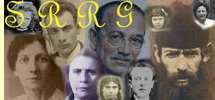|
Toledo, Ohio
The Rivers
"The struggling village of Toledo depended upon the Maumee River as a means of transportation. During the canal boom of the 1840s, the city underwent its first real expansion. By the late nineteenth century, Toledo was known for its port facilities, particularly for the shipping of bulk cargoes. When the St. Lawrence Seaway opened, Toledo competed vigorously with other Great Lakes ports. Today it is one of the nation's leading inland ports."(3)
|
The Maumee River
"Maumee River formed near Fort Wayne, Ind., U.S., by the confluence of the St. Joseph and St. Marys rivers. It flows northeast into Ohio, past Defiance and on to Toledo, where it enters Lake Erie through Maumee Bay. About 130 miles (210 km) long, the Maumee is navigable for about 12 miles (19 km) from its mouth and serves as the harbor of Toledo. It receives the Maumee River, its chief tributary, at Defiance. The name Maumee is a derivative of Miami, in reference to the Indian tribe."(4)
|
Dniester River
My father, Adolph Blitzer, swam across it at night to escape the Austrian soldiers who were shooting at him and Adolph's brother, Shapse. (see chapter 2)
"Ukrainian Dnistro, Russian DNESTR, ROMANIAN NISTRUL, MOLDOVAN NISTRU, Turkish TURLA, river of southwestern Ukraine and of Moldova, rising on the north side of the Carpathian Mountains and flowing south and east for 840 miles (1,352 km) to the Black Sea near Odessa. It is the second longest river in Ukraine and the main water artery of Moldova.
The Dniester and its tributaries drain a long, narrow basin that is about 28,000 square miles (72,000 square km) in area but is nowhere more than about 60-70 miles (100-110 km) wide. The river's basin is bounded on the north by the Volyn-Podilsk Upland and on the south of the river's upper course by the Carpathian Mountains. Farther to the south are hilly plains and the Bessarabian Upland, and at the Southeastern most end of the basin is the Black Sea Lowland. The estuary of the Dniester is formed by the incursion of the sea into the lower Dniester River valley, forming a shallow basin that is separated from the sea by a narrow strip of land. The Dniester has many tributaries, only 15 of which are more than 60 miles (95 km) long. They include the Stryy, Zolota Lypa, Strypa, Seret, Zbruch, Smotrych, Ushytsya, Murafa, Raut, Bāc, and Botna.
The climate of the river basin is humid, with warm summers. Annual precipitation varies from 40 to 50 inches (1,000 to 1,250 mm) in the Carpathians down to 20 inches (510 mm) near the Black Sea. A large proportion of the land of the basin is under cultivation.
The Dniester frequently floods, causing extensive damage to settled areas. The water level in its middle course varies by 25-35 feet (7.5-10.5 m) at different times of the year because of melting snow and rainfall in the upper part of its basin. The river's average discharge is about 10,000 cubic feet (300 cubic m) per second, but it has been known to reach 250,000 cubic feet (7,100 cubic m) per second or more at times of flood. Freezing usually occurs at the end of December or the beginning of January and lasts about two months; although in some years there is no icebound period.
Although the basin of the Dniester is densely populated, there are no large towns along the river itself. Lviv and Ternopil (Ukraine), Chisinau (Moldova), and other urban centres lie above the main valley on tributaries. The Dniester is navigable for about 750 miles (1,200 km) from its mouth; shipping lines run from Soroca to Dubasari (both in Moldova) and from Dubasari to the sea. Navigation is made difficult on the lower reaches by shallow water and sandbars. The river is used extensively for carrying logs, which are brought together at the mouths of the Carpathian tributaries and rafted downstream. Fishing is of little importance except near the coast. In the lower reaches and in the Dubasari Reservoir there are fish hatcheries for sturgeon, whitefish, pike perch, and carp."(5)
|
Home -
Introduction -
Prologue -
Preface -
Table of Contents -
Chapter 1 -
Chapter 2 -
Chapter 3 -
Chapter 4 -
Chapter 5 -
Chapter 6 -
Chapter 7 -
Chapter 8 -
Chapter 9 -
Chapter 10 -
Guest Book -
References
|
|




